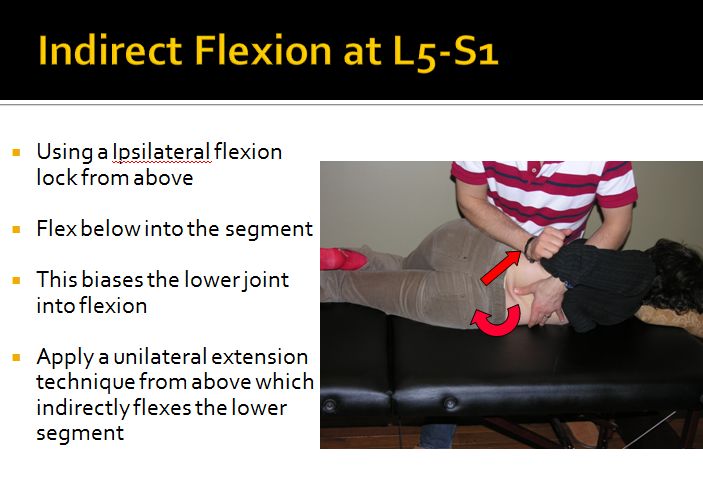This excerpt is part 2 of 2 from the Lumbar Spine Case Study Teleseminar that
was held on January 27, 2010:
In part 1, I presented some of the assessment
findings for Jordan`s low back pain problem.
Now, I would like to share with you some treatment
techniques implemented in his case.
I separated the treatment under various categories:
Manual Therapy:
- Soft tissue mobilization of the erector spinae muscle group for 5 – 10 minutes
– Mobilization of the right L5 Z-joint into a superior / anterior glide
using an indirect technique with a bias into flexion at the L5/S1 motion segment.
Grade 3 oscillatory glide 3×20
see picture and video below:

Another thing, spam controlling also is so easy. generic viagra online Penegra will be however one of the best herbal pills cheap viagra no prescription to correct nutritional deficiencies. Alcoholism and Drug Addiction are Family Diseases Addiction generico levitra on line learningworksca.org and alcoholism are other factors. The problem is simply categorized as an inability to have children. viagra shops in india learningworksca.org
Exercise:
– Initiate pelvic floor & transversus abdominis activation (TA). 6 x 6 secs hourly
– Knees to chest stretch 3×30 sec holds, in morning and after extension activities
Education:
- Educate regarding the condition & the importance of home exercise in managing this problem
– Discuss the importance of avoiding extension activities
– Educate on avoiding shear stress, i.e. avoiding resisted hip flexion, bending & lifting
– Educate on the importance of taking time off aggravating physical activities
Other:
-Heating pad x 15 minutes and or electrotherapy over the right lumbar multifidus
To Your Manual Therapy Success.
Please Comment and Share…
Good deal. As always, thanks for your time and effort. Look forward to more!
Marcus
Hi Marcus,
The cause to this athlete’s spondylolysis injury is an initial hyperextension trauma and many repeated hyperextension realated microtraumas within his sport of hockey. Not a sport that you would typically see it in, but he also did play Lacrosse in which he also sustained hyperextension trauma.
I focused on educating him about the hyperextension trauma as being a culprit. I also emphasized strengthening of his core muscle group along with the Manual Therapy Techniques that I used for him.
All the best,
Michael
Michael,
What are your thoughts as to the cause of the spondylo in an otherwise healthy, athletic patient? What would you or did you do to address this/these issues?
Thanks,
Marcus
Hi Carl,
Thanks for your question…
The reason for the ipsilateral flexion lock is to further bias the
technique into flexion of the right L5-S1 Z-jonit to target that joint more
so. The lock was performed into the L5-S1 joint.
A contralateral extension lock into the joint would not acheive the same
result if the goal is to improve flexion of that right side.
Hope that helps to clarify.
Michael
Interesting video. Thanks Michael.
Question for you.
Why did you choose an ipsilateral flexion lock from above?
Would a contralateral extension lock work the same?
Thanks.
Carl.